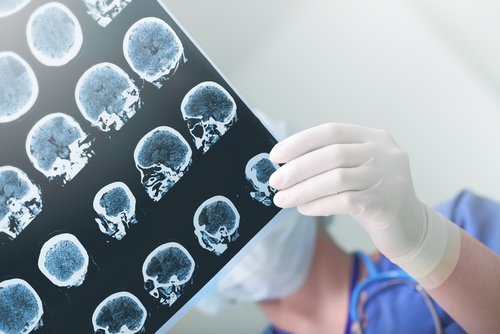The Differences between Dementia and Alzheimer's


Written and verified by the doctor Nelton Abdon Ramos Rojas
Did you know that dementia and Alzheimer’s are different diseases? However, it’s true that there are symptoms of dementia in both. In this article, we’ll take a look at the similarities and differences between the two.
First, what’s dementia?
Dementia
Dementia is the loss of cognitive functioning including thinking, remembering, and reasoning.
It also includes the loss of certain behavioral abilities to such an extent that it interferes with a person’s daily life and activities. Such functions include memory, language skills, visual perception, problem-solving, self-management, and the ability to focus and pay attention. Other significant functions affected by dementia are task planning and execution, abstract thought, emotional regulation, and resistance to fatigue.
Often, people with dementia can no longer control their emotions and their personalities often change. They simply become different people.
Dementia ranges in severity from the mildest stage – when it’s just beginning to affect a person’s functioning – to the most severe stage, when the person must depend completely on others for the basic activities of daily life.
There are multiple possible causes of dementia. Among them are Alzheimer’s, vascular diseases and other diseases of the central nervous system.
Dementia versus Alzheimer’s
Now, we’ll proceed to define these two diseases to clarify the distinction between them.
Dementia is not a concrete disease, but a set of symptoms that include the impairment of memory and other reasoning capabilities. These symptoms are severe enough to interfere with a person’s daily routine.

Dementia, as such, may be caused by various diseases. Thus, it may stem from Alzheimer’s or vascular disease or a condition of the central nervous system.
Dementia appears mainly in the elderly. However, according to specialists, dementia can affect people of any age.
You may be interested: Depression in Senior Citizens: How to Detect it in Time
Alzheimer’s Disease
Alzheimer’s is another type of dementia. However, it’s characterized by loss of neurons. Consequently, it involves the loss of synaptic density (synapse refers to the connection between two neurons).
In addition, various substances, such as amyloid material, lodge in the nervous tissue when a person has Alzheimer’s. Alterations in neurotransmitters also occur, causing the cerebral cortex to atrophy.
The Location of the Disease
Alzheimer’s a cortical type of dementia. Thus, it’s the gray matter that’s affected. Therefore, the functions controlled by the gray matter (cortex) are affected. These are essentially include judgment, memory, language, attention, and concentration.

Dementia, on the other hand, may be cortical or subcortical. In addition to affecting the above functions, it could also affect the functions governed by the subcortical brain layer. These include psychomotricity, emotions, slowness, apathy, and memory loss.
There are also two circumstances that are characteristic of subcortical dementia:
- Apraxias: loss of the ability to move as usual.
- Agnosias: loss of ability to recognize stimuli.
In addition, practically all forms of dementia change as they evolve.
Discover: 6 Brain Health Enemies that You Should Take Out of Your Diet Right Now
Progression of Alzheimer’s
The clinical picture of Alzheimer’s progresses for approximately 5 to 10 years.
Furthermore, it develops in stages:
- The first stage involves a decrease in resistance to fatigue and adaptability in certain activities. Then, small forgetfulness and negation of the disease appear along with worry and anxiety.
- During the second stage, there’s difficulty adapting to certain tasks. Also, there may be a loss of attention, concentration, memory, and depressive incidents.
- In the third stage, there’s a decrease in the ability to adapt to ordinary tasks. In addition, afflicted people may start to experience emotional de-regulation.
- During the fourth stage, the ability to adapt to ordinary tasks is already severely diminished. The person may no longer be aware of their illness and of the changes in their personality.
- At the fifth stage, people experience serious cognitive impairment.
- Finally, during the sixth stage, a person with Alzheimer’s no longer recognizes their relatives and is totally dependent on help.
Progression of Dementia
On the other hand, vascular dementia develops due to transient ischemic accidents (TIA). This means that the damage is cumulative and the evolution is intermittent. Abrupt decreases of the superior functions of the brain followed by stabilization periods occur.
Meanwhile, other types of dementia are due to more specific diseases of the nervous system. Thus, how they progress often depends on their cause.
Overall, Alzheimer’s is a disease that progresses slowly. However, dementia can evolve gradually (if it is, in fact, Alzheimer’s), in an intermittent fashion (if it’s causes by vascular disease), or depending on the specific diseases of the nervous system.
Epidemiology
Finally, the Alzheimer’s type of dementia tends to more women than men. However, dementia affects men more if the cause is vascular.
Currently, there’s no cure for dementia or Alzheimer’s. However, there are treatments for symptoms. Research continues. Although current Alzheimer’s treatments cannot stop it from progressing, they can temporarily slow down symptoms and improve the quality of life of those afflicted with the condition and for their caregivers.
Fortunately, there’s a worldwide effort underway to find better treatments for these diseases, delay their onset, and prevent them overall.
All cited sources were thoroughly reviewed by our team to ensure their quality, reliability, currency, and validity. The bibliography of this article was considered reliable and of academic or scientific accuracy.
- Berchtold, N. C., & Cotman, C. W. (1998). Evolution in the conceptualization of dementia and Alzheimer’s disease: Greco-Roman period to the 1960s. Neurobiology of Aging. https://doi.org/10.1016/S0197-4580(98)00052-9
- Miyoshi, K. (2009). What is “early onset dementia”? Psychogeriatrics. https://doi.org/10.1111/j.1479-8301.2009.00274.x
- Vinters, H. V. (2015). Emerging Concepts in Alzheimer’s Disease. Annual Review of Pathology: Mechanisms of Disease. https://doi.org/10.1109/HICSS.2013.173
- Alzheimer’s Society. (2014). What is Alzheimer’s disease ? Factsheet 401LP. https://doi.org/10.1007/s10483-010-0306-9
This text is provided for informational purposes only and does not replace consultation with a professional. If in doubt, consult your specialist.








